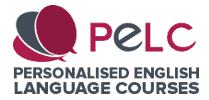The advantages of using authentic materials in the EFL classroom
In my first two years of EFL teaching, I wasn’t aware of the advantages of using authentic materials in the classroom.
Like many post-CELTA teachers, I was emotionally attached to the dreaded grammatical syllabus and turning pages in coursebooks.
I mostly taught lower level learners early on in my career. However, there was such a range of authentic materials I could have brought to the table. For instance, I could have exploited songs, posters, flyers, menus and video and audio advertising.
Planning the odd class around such authentic materials would have broken up the monotony of using coursebooks and boosted my students’ motivation levels.
First of all in this post, I define what authentic materials are, and also consider a definition of authentic discourse. After that, I assess the problems with coursebooks and contrived discourse in EFL classrooms. I then go on to analyse the issues with using textbooks and relying on contrived discourse. Then, I briefly explain why a teacher’s self-written texts can create intrigue among learners. After that, I offer three tasks connected with various discourse types which are ideal for use in the classroom. Finally, I highlight the advantages of using authentic materials in the EFL classroom.
WHAT ARE AUTHENTIC MATERIALS?
Authentic materials are audio, print and video materials that have not been designed for deliberate use in the English language classroom.
Authentic materials may fall into two main categories - print and auditory.
Let’s check out some examples of authentic materials from each category:
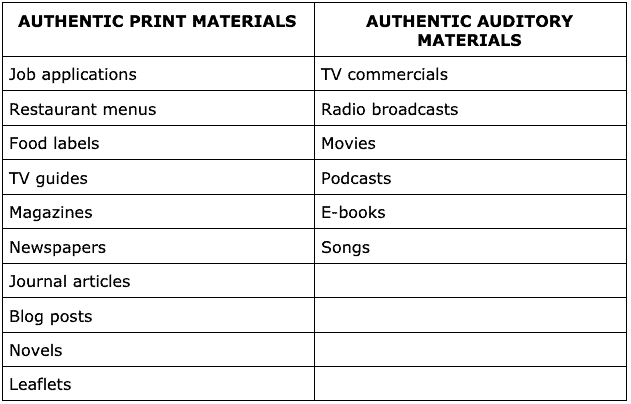
WHAT IS AUTHENTIC DISCOURSE?
In his 2011 paper, “I prefer Not Text”: Developing Japanese Learners’ Communicative Competence with Authentic Materials, Alex Gilmore picks out a definition of authentic discourse that Keith Morrow made back in 1977:
a stretch of real language, produced by a real speaker or writer for a real audience and designed to convey a real message of some sort
Hence, stretches of “real language”, for instance, from political speeches and audio advertising, are wholly detached from the contrived discourse omnipresent in coursebooks.
The purpose of an authentic text is to communicate information. In contrast, 'imaginary' texts and dialogues found in textbooks tend to illustrate and expose specific language points.
THE PROBLEMS WITH COURSEBOOKS AND CONTRIVED DISCOURSE IN EFL CLASSROOMS
During the first few years of my teaching career, I was oblivious to the wide-ranging advantages of using authentic materials with students.
Unfortunately, I couldn’t tear myself away from the coursebooks and contrived discourse.
That's right. I was afraid to step out of my comfort zone.
I now know that writers come up with this contrived discourse to illustrate specific points in linearly designed structural syllabuses. Hence, authors’ intuitions produce misleading models of the target language.
Take a look at these two contrived auditory samples from the fourth edition of New Headway Upper Intermediate (2014). I’ll make some comments below them.
SAMPLE 1
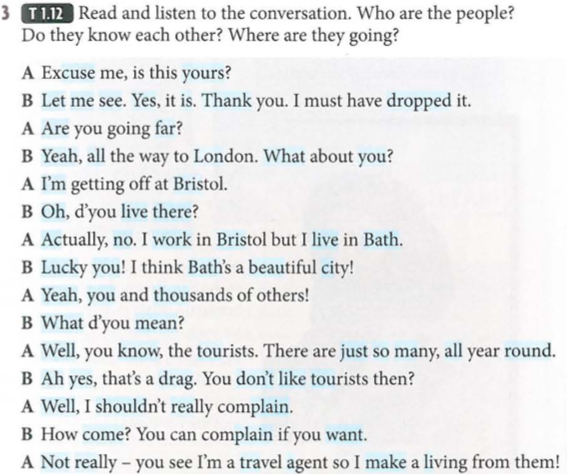
- I don’t even have to listen to the recordings to know that the intonation used by A and B is shamefully artificial. There’s too much politeness and formality
- Such an abundance of exclamation marks smacks of artificiality and contrivance
- A and B have known each other for a few seconds yet they speak to each other as if they’re lifelong friends. Look at the use of the personal pronoun you and the part joke, part direct command, “You can complain if you want.”
- The follow up exercise (see below) suggests that the exercise has an agenda - for students to practise word stress. Hence, the authors don’t intend to convey a real message
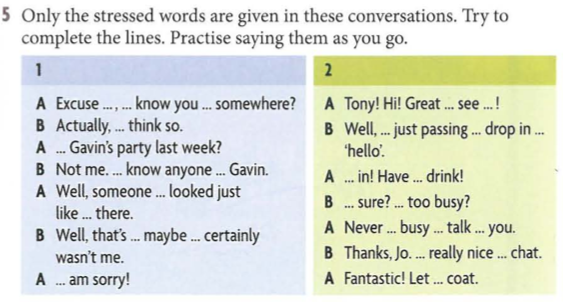
SAMPLE 2
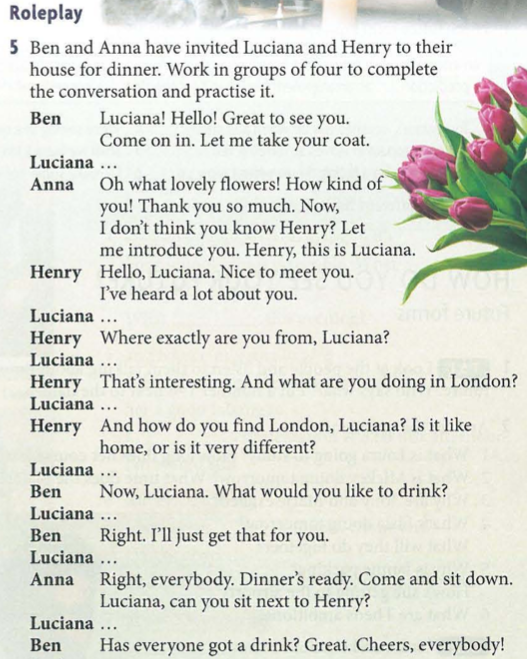
- The repetition of “Luciana” is very unnatural
- Anna introduces Henry to Luciana in such a long-winded and overly polite fashion
- Shortened utterances and sentences; fewer clauses
SIMPLIFICATION IN COURSEBOOKS
Browse a range of ELT coursebooks and you will notice the traditional strategy they use - simplification.
Essentially, writers simplify input by making syntactic and morphological adjustments in speaking and writing.
These changes include fewer clauses, adherence to canonical word order (SVO - subject-verb-object) and shortened sentences/utterances.
Regarding phonology, native speakers tend to address non-native speakers unnaturally in coursebook dialogues. For instance, they often use more careful articulation, slower speech rate, less contractions and artificial stress and pauses to emphasise key words.
Mishan (2005, p.24) makes the point that, by simplifying and shortening texts, coursebook writers may banish elements vital to comprehension.
Put simply, coursebook writers impoverish learners’ input!
My biggest concern is that simplification sends the erroneous message that ‘every word in a text is significant’. (Young, 1999: 361, cited in Mishan, 2005, p.24).
COURSEBOOKS AVOID NON-STANDARD SPOKEN FORMS
Coursebook writers tend to stick blindly to the structural syllabus.
One example to back up my assertion is the pointless teaching of passives.
Look at the examples below, from New Headway Upper Intermediate (2014) once again:

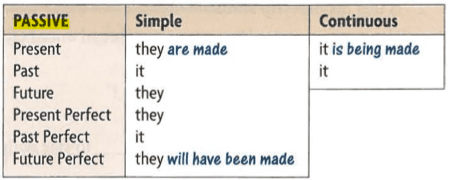
Passive tense aspects are not common in spoken English.
Frankly, I’m not sure I’ve ever uttered a sentence that contains a future perfect passive or past perfect passive.
So, why don’t coursebooks promote the teaching of the get passive? This item is very common in informal spoken English?
Here are some example sentences with the get passive:
1. Jane finally got promoted after several years of hard work (‘get promoted’ = extremely common)
2. Unfortunately, my fruit trees got damaged in the wind yesterday
3. They had only known each other for a few months when they got married in New York City last month
4. My father got sacked last week
5. Our car got stolen last night
All in all, I believe that the get passive should be treated lexically, rather than grammatically. Indeed, phrases like get promoted play a lexical-communicative role in communication - not a grammatical role.
A TEACHER'S OWN TEXTS WHICH ERR ON THE SIDE OF AUTHENTICIty
I’ve been writing texts based on my own life experiences for a number of years now.
What is unique about these texts is that I do my utmost to make the language resemble natural spoken English.
Check out the text below:
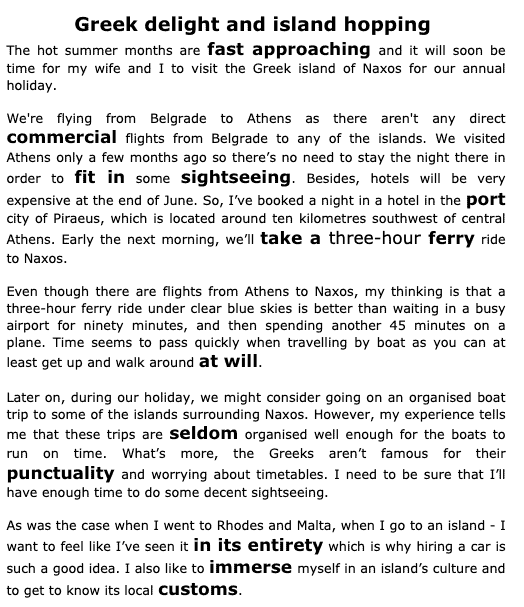
Notice the use of contractions (aren’t instead of are not) and the personal pronouns I and we.
There are also plenty of collocations and chunks of language commonly found in spoken English. These include the phrasal verb fit in, get to know, do some sightseeing and stay the night.
All in all, I believe a teacher’s own texts are authentic in the sense that they’re true stories which aim to communicate information. When I sit down to write about something I’ve experienced, it’s never my intention to expose certain language points and structures.
TASKS CONNECTED WITH VARIOUS DISCOURSE TYPES WHICH EFL TEACHERS MAY INCORPORATE INTO THEIR TEACHING PLANS
There’s no better way to illustrate the advantages of using authentic materials than by presenting a selection of tasks which exploit authentic discourse types.
The three tasks below appear in Mishan’s 2005 book: Designing Authenticity into Language Learning Materials.
TASK 1

Preparation:
This task may be suitable for advanced level learners who share the same mother tongue.
Find a short passage from a novel where at least one delexical word is used with a number of different meanings (e.g. get/got might appear in the same passage as: got lost, got a letter, got to go).
Procedure:
1. Split the class into smaller groups
2. Pre-teach some delexical verbs that are used with a number of different meanings. For instance:
- take - take a shower, take a photo, take a chance
- have - have a conversation, have an argument, have a rest
- get - get lost, got to go
- do - do my hair, do the cooking
- make - make noise, make a promise, make a suggestion
- go - go swimming, go for a walk
3. Assign a target word to each group (e.g. get or go)
4. Groups should find all occurrences of their target word, and analyse the meanings in context. They should note down the various ways the word/s can be used
5. Encourage learners to think about how each use in context represents a certain language register and has implications for meaning
6. Groups translate the expressions containing the target word/s into their first language. Learners should pay heed to the meaning in context, register etc.
7. Groups then re-translate their translated items back into English. They should keep as close as possible to the foreign language word/s. For example, the English expression 'I don’t get it’ may be translated into Serbian as ‘ne kapiram’. This re-translates into English as ‘I have not understood’.
8. Feedback stage - groups share their insights with other groups
COMMENTS ON THE USE OF NOVELS IN THE CLASSROOM
To my huge regret, I haven’t used literature in the language classroom and with private students online very much over the past fifteen years.
Novels offer enormous scope, ranging from being deeply culture specific to being universal.
Nevertheless, it’s a novel’s ability to raise awareness of cultural identities that is its most alluring feature.
As Mishan (2005, p.112):
Literature is, after all, the most intense and intrinsically the most dense representation of the culture and the people who comprise it.
TASK 2

Preparation:
This task suits pre-intermediate and intermediate level learners.
Cut out a number of striking or shocking photographs from newspapers.
Procedure:
1. Present each photo in turn to the class (use the originals if a single copy will be visible to the whole class - if not, duplicate the photo as closely as possible).
2. Elicit what the learners know about the story behind each photo (use - Who...? What...? Where...? etc.)
3. If applicable, ask learners to interpret the emotions of the subject/s in each photo - distressed, happy, embarrassed, proud etc
4. Elicit learners’ own emotive reactions to the photo (‘how does this photo make you feel?’)
5. Discussion of ethics - should newspapers publish controversial photos (is it fair on the people/events they show or on the readers?)
6. In small groups or as a class discussion, learners compare the ethics of the press in their own cultures
TASK 3

Preparation:
Select a film with a significant opening sequence/scene. For example, it may show an important event or piece of action, or provide important background to key character/s.
Procedure:
1. Mute the sound, if there is dialogue
2. Show the sequence (without sound) and ask learners to speculate:
- Where the scene is taking place
- What they infer about the character/s figuring in it
- The genre of the film and the main plot
3. Learners can now speculate what is being said and produce a feasible dialogue in small groups
4. Play the sequence with sound and compare learners’ dialogues with the actual one
5. If there’s any music, elicit how it adds to the impact of the scene
ThE ADVANTAGES OF USING AUTHENTIC MATERIALS
Here’s a summary of the main advantages of using authentic materials:
- Authentic materials for non-linear syllabi - There’s little evidence of a fixed acquisition order when it comes to authentic materials. Many teachers and scholars might repudiate the use of authentic texts on this basis. However, I believe that language acquisition does not occur in a magical linear fashion;
- Integrative motivation - Genuine materials from the target culture provide learners with a crucial ‘stepping stone’ towards their own understanding of, and adaptation to, that culture;
- Confidence levels rise when learners are treated as ‘native speakers’ - Distributing authentic materials in class might cause students to believe they are being treated as ‘native speakers’. Therefore, their confidence levels rise and their overall learning experience is enhanced;
- Enhanced engagement - Engagement in a text assumes a certain degree of empathy. Indeed, authentic materials tend to have great personal significance for learners. Hence, a powerful argument in favour of utilising authentic materials is the increased levels of engagement they tend to foster;
- Accessibility to low level learners - Low level learners can approach genres such as the television news bulletin with confidence. Learners should be familiar with the presentation and format of the news bulletin, mostly owing to its use of visual images. Instructors should teach low level learners how to recognise proper nouns (people and places) and ‘international’ words (e.g. airport, terrorism). Moreover, teachers should encourage learners to contribute their own knowledge about items in the news.
Final Thoughts
The advantages of using authentic materials in the EFL classroom far outweigh the drawbacks.
In my view, there is an argument that entire courses should revolve around authentic materials, even for lower level learners.
So, perhaps, Directors of Studies and teachers don’t need to devise syllabuses at all.
After all, language acquisition is haphazard and scatty, not formulaic and linear.
References
Gilmore, A., (2011). ' “I prefer Not Text”: Developing Japanese Learners’ Communicative Competence with Authentic Materials', Language Learning: A Journal of Research in Language Studies, September 2011, pp.786-819
Mishan, F., (2005). Designing Authenticity into Language Learning Materials, Bristol: Intellect Books
